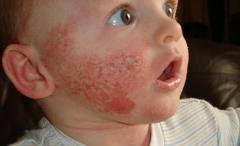Adverse
reactions to foods are relatively common in both children and infants. When
severe reactions such as anaphylaxis occur immediately after ingestion, it is
usually not difficult to identify the offending food. Anaphylaxis, with
respiratory and cardiovascular collapse, is the most severe reaction following
ingestion. In young children, other reactions such as colitis may occur.
In infants, food allergies may cause colic,
vomiting, feeding problems, or growth failure. Most food allergies in young
children resolve with time, although allergies to peanuts, which can be
particularly severe, often remain for life. Food protein-induced proctocolitis
and enterocolitis are food reactions that primarily affect infants,
commonly caused by sensitivity to cow’s milk protein.
Infants have dysphagia, vomiting, and abdominal
pain, often caused by sensitivity to various food proteins. Food reactions
are difficult to diagnose because reliable tests are not widely available.
Please take your children or infants to the
clinician for food skin testing. Adverse reactions resulting from food
poisoning, pharmacologic effects, and gastrointestinal (GI) disorders must be
ruled out. Skin tests for foods can be performed to confirm food allergies.
Food skin testing or RAST has relatively low specificity, in that positive
tests may occur in patients not experiencing allergic reactions to the
particular food.
Skin tests
or RAST are of limited value for diagnosing food protein-induced proctocolitis
and enterocolitis. A more definitive, although more time-consuming, test for
food allergies and food intolerance is the double-blind placebo-controlled food
challenge in which the patient is given increasing oral doses of the suspected
food in a blinded fashion. Once food allergies have been identified, the
treatment is dietary avoidance of the offending food or foods.
Anaphylaxis
is an acute, severe, life-endangering situation caused by an immunologic
reaction. Peanuts and tree nuts are the foods most likely to cause severe
anaphylaxis. Virtually any foreign substance, including foods or
latex-associated proteins, and therefore induce an anaphylactic reaction



0 Comments